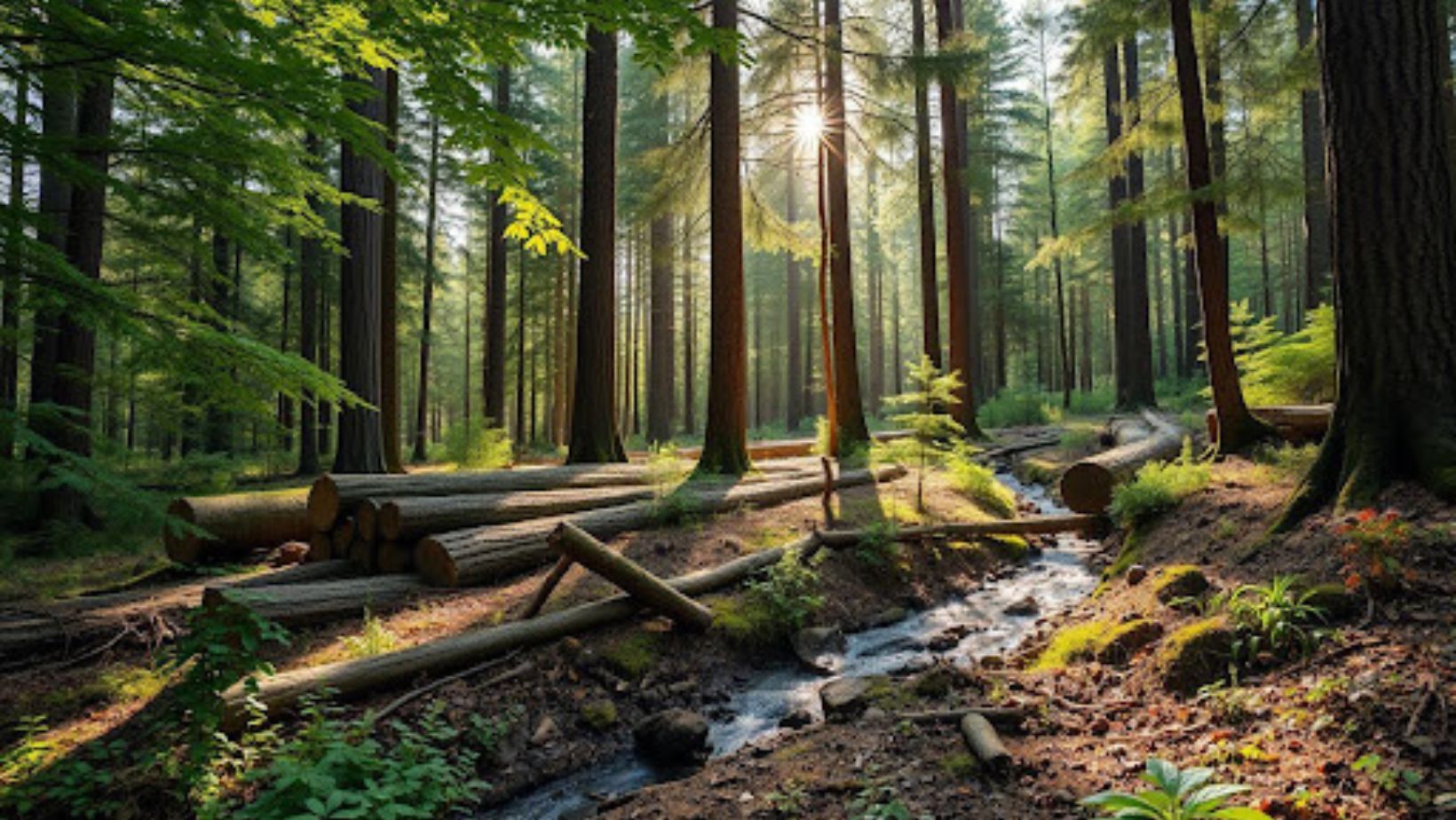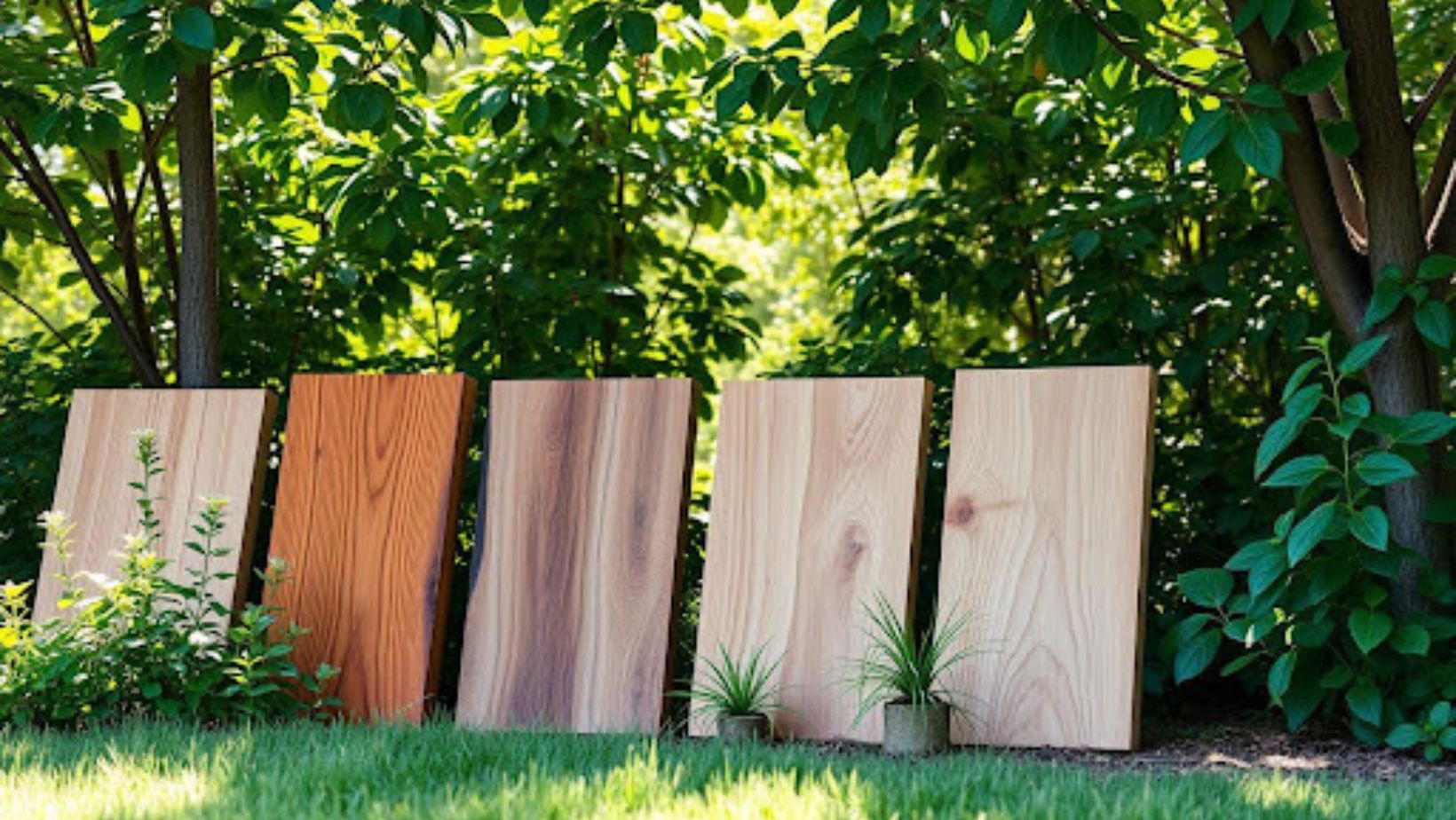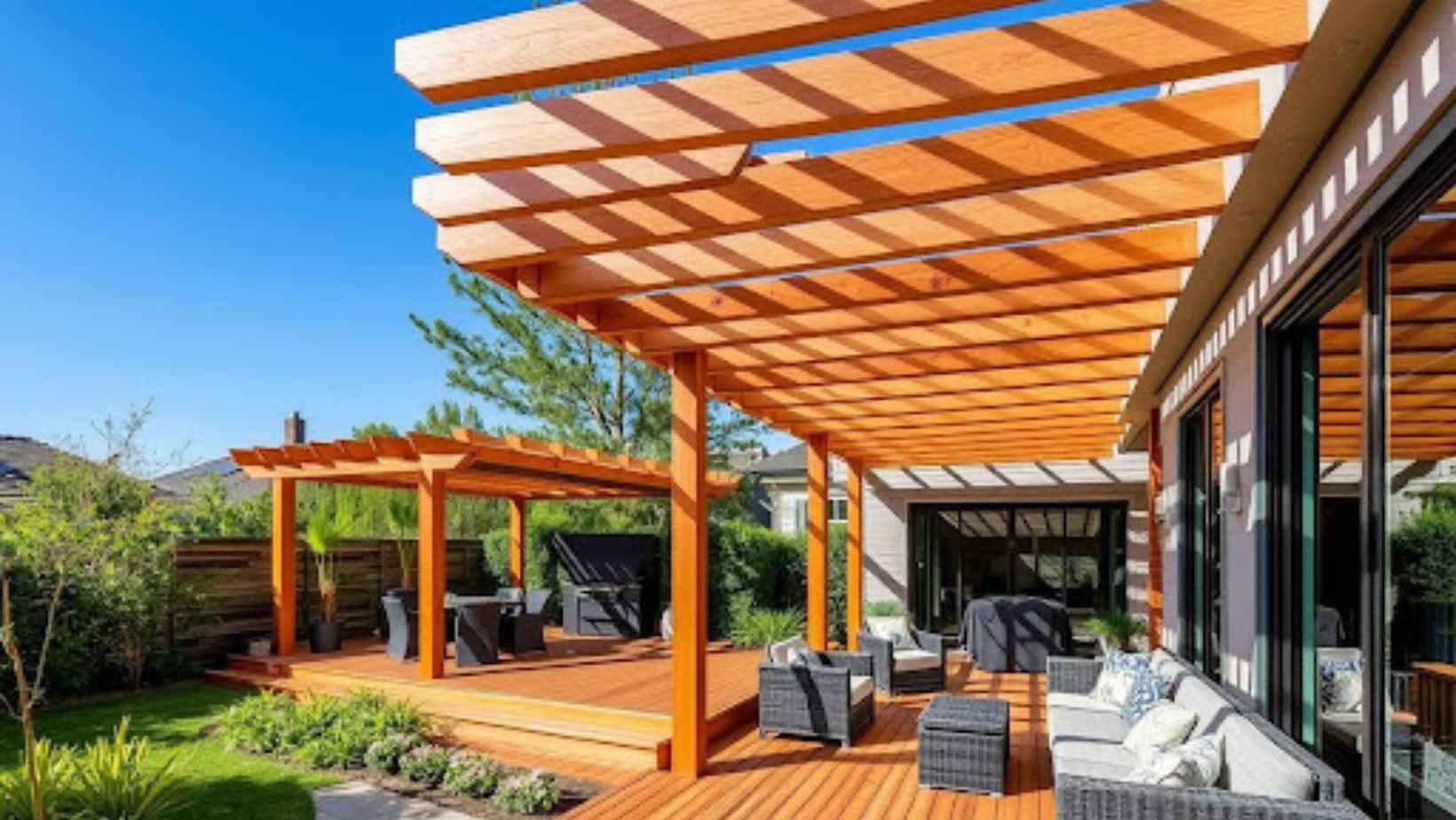
Key Takeaways
- Timber offers unparalleled natural beauty and aesthetic appeal for outdoor design
- Wood is a durable and long-lasting material that can withstand the elements
- Timber construction is a cost-effective solution for outdoor structures
- Timber is a versatile material that can be used in a variety of outdoor applications
- Sustainable forestry practices ensure the environmental benefits of choosing timber
Understanding the Natural Beauty of Wood in Outdoor Design
Lumber and timber are key in outdoor design, blending natural beauty with lasting durability. We’ll explore wood’s aesthetic appeal in outdoor spaces. This includes wood grains, natural weathering, and timber colors.
The Aesthetic Appeal of Different Wood Grains
Wood grains offer a feast for the eyes with their intricate patterns and textures. Oak has bold, swirling grains, while maple has delicate, linear patterns. Each lumber species has its own look, adding depth and elegance to outdoor spaces.
How Natural Weathering Enhances Character
Timber changes beautifully as it’s exposed to the elements. The wood manufacturing process meets sun, wind, and rain, creating a unique patina. This weathering softens wood edges and adds timeless charm to outdoor areas.
Color Variations in Different Timber Species
The world of lumber offers a wide range of colors. Cedar has warm, honey tones, while walnut has deep, chocolate shades. Each timber species has its own color, allowing for outdoor spaces that blend with nature or stand out.
| Timber Species | Color Range |
| Cedar | Warm, reddish-brown tones |
| Redwood | Vibrant, rust-colored hues |
| Teak | Rich, golden-brown shades |
| Ipe | Deep, chocolate-like tones |
“The natural beauty of wood is a true gift, offering a warm and inviting aesthetic that seamlessly connects the built environment with the great outdoors.”
The Environmental Benefits of Choosing Timber
Choosing the right materials for outdoor spaces is key to sustainability. Timber, being renewable and eco-friendly, offers many benefits. It’s a great choice for both homeowners and designers.
Sustainable forestry is at the heart of responsible timber use. It ensures timber is harvested to keep forests healthy and growing. This approach not only keeps our landscapes beautiful but also fights deforestation.
Timber is also great at capturing and storing carbon dioxide. As trees grow, they absorb CO2, turning it into wood. This helps reduce the carbon footprint of our outdoor spaces, making them greener.
“Sustainable forestry practices are essential for ensuring that the timber we use in our outdoor projects is harvested responsibly and with the environment in mind.”
Timber has more benefits than just being renewable and carbon-storing. It’s often more energy-efficient than other materials. This means less energy is needed to extract, process, and transport it, reducing its carbon footprint.
The choice of timber is vital for the environment. By picking sustainably sourced and managed timber, we can build beautiful outdoor areas. These areas not only look great but also help our forests and the environment.
Durability and Longevity of Timber Structures
Outdoor spaces need materials that last. The lumber industry has improved timber structures a lot. This is thanks to better wood processing and timber trade practices.
Weather Resistance Properties
Timber structures are great for outdoors because they resist weather well. Wood naturally handles moisture, UV rays, and temperature changes. This means timber structures stay strong and look good for a long time.
Treatment Options for Extended Lifespan
The lumber industry offers treatments to make timber structures last even longer. These include preservatives, coatings, and finishes. These treatments protect wood from the environment and pests, reducing the need for frequent replacements.
Maintenance Requirements Over Time
Timber structures are durable but need some care. Regular cleaning and inspections keep them in top shape. The wood processing and timber trade industries help with maintenance tips for different woods.
| Wood Species | Weather Resistance | Treatment Options | Maintenance Requirements |
| Teak | Highly resistant to weathering and moisture | Minimal treatment required, natural oils provide protection | Occasional cleaning and oiling to maintain the patina |
| Cedar | Moderate resistance to moisture and UV exposure | Can be treated with preservatives for enhanced durability | Regular cleaning and occasional re-sealing or staining |
| Pressure-treated Pine | High resistance to rot, insects, and weathering | Pre-treated with preservatives during the lumber processing | Minimal maintenance required, occasional cleaning |
Knowing how durable timber structures are helps in designing outdoor spaces. The wood processing and timber trade industries keep improving. They offer solutions for long-lasting enjoyment of timber in outdoor features.
Cost-Effectiveness of Timber vs Other Materials
Choosing the right materials for outdoor spaces is key to keeping costs down. Timber, a green and flexible option, is a great choice over concrete, steel, or plastic. Let’s look at why timber is a smart pick for outdoor areas.
Timber is often cheaper to start with than other materials. The U.S., for example, is a big player in wood exports and wood imports. This means timber prices are more competitive, appealing to those watching their budgets.
Timber also needs less upkeep over time. With the right care, it can last for decades, saving you money on repairs. This makes timber a wise choice for your wallet.
The logging industry has improved, making timber even more affordable. New ways to harvest and process wood have cut costs. This is good news for those looking to save money on outdoor projects.
Looking at the long run, timber is a smart financial choice. It’s affordable upfront and lasts a long time with little upkeep. This makes it a better option than many other materials.
“Timber is a cost-effective building material that offers exceptional value for money in outdoor spaces.”
In summary, timber is a cost-effective choice for outdoor spaces. Its abundance, durability, and the logging industry’s efficiency make it a great option. It allows for beautiful, affordable outdoor areas that last.
Popular Timber Species for Outdoor Applications
Choosing the right timber species is key for outdoor spaces. It affects the look, durability, and performance of your project. Hardwoods, softwoods, and exotic options each bring their own charm and benefits.
Hardwood Options for Outdoor Use
Hardwoods like oak, teak, and cedar are known for their strength and beauty. They’re perfect for outdoor furniture, decking, and areas that get a lot of use. Their dense grain and oils protect them from moisture, insects, and weather.
Softwood Alternatives and Their Benefits
Softwoods like pine, fir, and redwood also have their perks for outdoors. They’re cheaper, lighter, and simpler to work with. This makes them great for fencing, sheds, and some decking.
Exotic Wood Species to Consider
- Ipe, a dense and durable tropical hardwood, is ideal for busy spots like decks and docks.
- Bamboo, a grass-like wood, is becoming popular for its eco-friendliness and unique look in outdoor furniture and structures.
- Garapa, a Brazilian hardwood, has a warm color and stands up well to weather, making it a favorite for outdoors.
When picking timber for your outdoor projects, think about durability, weather resistance, appearance, and sustainability. Knowing what each timber type offers helps you choose wisely. This ensures your outdoor spaces look great and last long.
Design Versatility with Timber Construction
Outdoor spaces really come alive with wood construction. It can go from classic to modern, fitting any style. Whether you want a cozy retreat or a sleek oasis, wood makes it possible.
Wood is great because it mixes old and new styles easily. It adds warmth to traditional designs and modern structures. This makes any outdoor area inviting and stylish.
There are many wood types, each with its own look and feel. You can mix them for amazing contrasts. For example, hardwoods like oak and mahogany offer deep colors, while softwoods like cedar and pine are lighter.
Wood is also super flexible for building. You can make everything from big pavilions to small details like railings. This lets you create spaces that are truly yours, showing off your personal style.
| Wood Species | Grain Pattern | Color Range |
| Oak | Straight, Coarse | Light to Dark Brown |
| Mahogany | Straight, Fine | Reddish-Brown |
| Cedar | Straight, Smooth | Reddish-Brown to Pinkish |
| Pine | Straight, Coarse | Pale Yellow to Light Brown |
Wood construction lets you dream big for your outdoor space. Whether rustic or modern, wood brings your vision to life. It turns your outdoor areas into special places.
Sustainable Forestry and Responsible Wood Selection
We all need to make smart choices when buying timber. Taking care of our forests is key to keeping nature healthy. By knowing about timber trade rules, we help our outdoor projects help the planet.
Certification Systems and Standards
Groups like the Forest Stewardship Council (FSC) and the Sustainable Forestry Initiative (SFI) set rules for good forestry. They check if forests are protected, if animals and plants are safe, and if trees are cut down right.
Environmental Impact Considerations
- Deforestation and habitat loss: Good forestry keeps nature safe, protecting animals and plants.
- Carbon sequestration: Healthy forests pull carbon dioxide out of the air, helping fight climate change.
- Biodiversity preservation: Careful forest management keeps a variety of life forms, keeping nature in balance.
| Certification Program | Key Principles | Environmental Benefits |
| Forest Stewardship Council (FSC) | Sustainable forest management, social responsibility, environmental protection | Habitat conservation, reduced deforestation, support for local communities |
| Sustainable Forestry Initiative (SFI) | Responsible forestry practices, wildlife conservation, water quality protection | Biodiversity preservation, watershed management, climate change mitigation |
Choosing timber with the right certifications means our projects help the environment. It’s a small step towards a better future.
Installation Tips and Stunning Practices
Installing timber structures outdoors requires careful planning. As a lumber industry expert, I’ve found that paying attention to details is crucial. Each step, from site preparation to securing the wood, is important for a sturdy and lasting structure.
First, make sure the ground is level and the soil is compacted. This creates a stable base for your timber. Using stainless steel or weather-resistant fasteners also helps the structure last longer.
Wood treatment and finishing are also key. A good sealant or stain protects the wood and makes it look great. Regular upkeep, like cleaning and re-sealing, keeps your outdoor spaces beautiful for years. By following these tips, you can enjoy beautiful, long-lasting outdoor spaces that highlight the beauty of wood.
FAQ
What Are The Benefits Of Using Timber For My Outdoor Spaces?
Timber brings many benefits to outdoor areas. It’s beautiful, durable, and versatile. Its natural look, ability to age well, and many colors make it perfect for lasting outdoor spaces.
How Does The Natural Beauty Of Wood Enhance Outdoor Design?
Wood’s natural beauty is captivating in outdoor design. Its unique patterns, weathered character, and colors add beauty to outdoor spaces.
What Are The Environmental Benefits Of Choosing Timber?
Timber is good for the environment. It’s renewable and helps absorb carbon. Sustainable forestry practices make it a green choice.
How Durable And Long-Lasting Are Timber Structures For Outdoor Use?
Timber structures last a long time outdoors. They resist weather well and can be treated to last even longer. With care, they can last for years.
Is Timber More Cost-Effective Than Other Materials For Outdoor Spaces?
Timber can be cheaper for outdoor spaces. It’s affordable upfront and has low maintenance costs. Its long-term value and industry economics make it a smart choice.
What Are The Most Popular Timber Species For Outdoor Applications?
Many timber species are great for outdoors. Hardwoods, softwoods, and exotic woods each have their own benefits. They suit different outdoor needs.
How Versatile Is Timber Construction For Outdoor Spaces?
Timber construction is very versatile for outdoors. It fits many styles and uses. This makes it a great choice for outdoor designs.
How Can I Ensure Sustainable Forestry Practices And Responsible Wood Selection?
Choosing sustainable timber is important. Look for certifications and follow environmental standards. This helps protect ecosystems and biodiversity.
What Are The Outstanding Practices For Installing Timber Structures In Outdoor Spaces?
Proper installation is key for timber structures outdoors. Use the right tools and follow best practices. This ensures they last and look good.


















